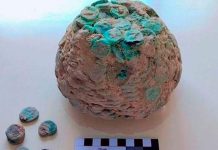A species of genus Zanda found in southwest Australia is Baudin’s black cockatoo (Zanda baudinii), also known as Baudin’s cockatoo or the long-billed black cockatoo. Recent research suggests there are actually two species of White-tailed Black Cockatoo in southwestern Australia. In order to obtain the seeds of proteaceous shrubs and pines, one bites into and breaks open their cones with its short, round bill.
A second species described here uses seeds from the capsules of the marri Eucalyptus calophylla instead. In terms of outward appearances, the only difference is the bill, as both have black and white plumage patterns, different sexual characteristics, and thin, finely curved feet.
The cockatoos in eastern Australia have slender, rounded bills, whereas the cockatoos in western Australia have longer, slenderer bills with exceptionally long tips for levering out food. With its attenuated upper mandible, it deftly removes the seeds from the capsule with ease. This is after clipping off a capsule, transferring it to the left foot, and then deftly transferring it to the right foot.
In addition to the horny covering on the bill, X-rays show that the maxilla (upper jaw) is strongly extended in order to support the elongated upper mandible. A Long-billed Black Cockatoo is not restricted to trees or to eating marri seeds as part of its diet.
They often feed on the bull banksia Banksia grand, extracting its seeds, as they do the seeds of the marri. They also gouge wood-boring larvae from their holes in timber, win nectar from the blossoms of banksia and marri, and even dig into growing apples and pears for their seeds, discarding the fruits.
Their diets include wild geraniums Erodium, and fallen marri nuts and seeds shed by burnt trees after bushfires, as does the White-tailed Black-Cockatoo. As far as habits, breeding, and aspects of their life history are concerned, long-billed black cockatoos seem to be similar to other white-tailed cockatoos.
The bird’s pair permanently, are similarly communal, and although rarely gathering in flocks over 50, the birds fly between roosting and feeding sites with the same slow, buoyant flapping. This gives strange wailing sounds.
A broad range of colors is found in tall karri Eucalyptus forests in the extreme southwest, where breeding occurs. As their young grow, they migrate northwards with their flocks, reaching the Darling Range east of Perth and the Stirling Range north of Albany, where there is close forest. The White-tailed Black Cockatoo overlaps widely with them at such times, but their flocks do not mix.

Baudin’s Black Cockatoos measure approximately 550-600 millimeters in length with long tapered tails about half their length. The body plumage of the male bird is dusky black with off-white feather edges, giving it a scalloped appearance on the underside.
The wings are dusky in color. Two all-black feathers cover the center of the tail, with a plain white band at the end. The cheek has a small patch of grayish-white color. There is bare skin around the eyes, which is pink, and dark brown eyes. Having a gray-black bill with a long tapered tip and a maxilla, it is very slender with a very slender bill. Dark grey-brown feet and toes with dark claws.
A female has the same features as a male, except her cheek patch is larger and whiter; her bare skin around her eyes is dark grey; her bill is bone-colored with a dark tip on her upper mandible, and her feet are flesh-colored. Female immatures have a similar cheek patch to adult females, but male immatures may have a smaller, duller patch. Long and cream-colored, the downy young bird has pale bill.
Baudin’s Black Cockatoos make a high-pitched, drawn-out, wailing whistle, whee-la, as their contact call in flight. About a half-second call, the last syllable is rather short and not much longer than the first. Likewise, a harsh screech of one syllable in alarm. A young bird that has just fledged wheezes or rasps constantly and harshly.
From August to January, eggs are laid and nests are built. In trees, nests usually have a large hollow, usually 20-30 meters up in karri or jarrah. Approximately 190-200 mm is the diameter of the entrance, which widens to 350 mm at the floor; 150 mm is the depth of the nest. After selecting and preparing the hollow, the female lines the floor with m10d chips from the sides, and enters the hole tail first.
There are usually two eggs that are white in color laid by the bird. They are oval-shaped and measure about 48 x 35 mm in size. Approximately four weeks are required for incubation by the female. In most cases, only one young survives to fledge.
This species is commonly found in forests and hills covered with jarrah Eucalyptus marginata and karri Eucalyptus diversicolor in extreme southwestern Australia. When not nesting, this striking cockatoo forages further north in the Darling Ranges and the Stirling Ranges.
Read More – Musk Lorikeet (Glossopsitta concinna)







